1 Chapter 1 – What is IS?
Learning Objectives
1.1 Understand the various definitions of information systems.
1.2 Explain the data-to-value process and its relation to the Input, Process, Output (IPO) model.
1.3 Understand the importance of information in decision making.
1.4 Differentiate between information technology (IT) and information systems (IS).
The ever-changing definition of information systems
A simple, beginning question such as “What is an information system?” will begin your journey down the complex, dynamic, and situational world that is information systems. Within the scope of information systems, the term ‘IS’ can refer to the field of information systems, a departmental unit within an organization, the overall information systems in use and even be used to describe specific components within an information system. The key to understanding which the focus is to also understand the context of the information being presented. For example, a discussion about issues related to a process or procedure most likely refers to a specific portion of the information systems in use. Discussing the difficulties in learning a new system in general, however, likely refers to the field of information systems.
While almost all information systems are unique in their own way, the do classify into common groupings. A person may be familiar with terms such as management information systems, geographic information systems, enterprise systems, social information systems, etc. These various categories of information systems can help further define the purpose of the information system. However, the question is what do all these systems have in common and how are information systems defined?
Information systems can be defined using the following: [Type] [Purpose] [System] (TPS). While there are variations of system ‘naming’ that go outside of these parameters, many systems will be named within this style. Let’s start with management information systems. ‘Management’ has varying definitions as well, and for the sake of this text, we will use the Bateman & Snell (2013) definition of “the pursuit of organizational goals through organizational resources”. ‘Information’, as a broad definition, is considered data presented in a context. ‘System’ ultimately is defined as a group of components working together. Now let’s examine these terms through combinations.
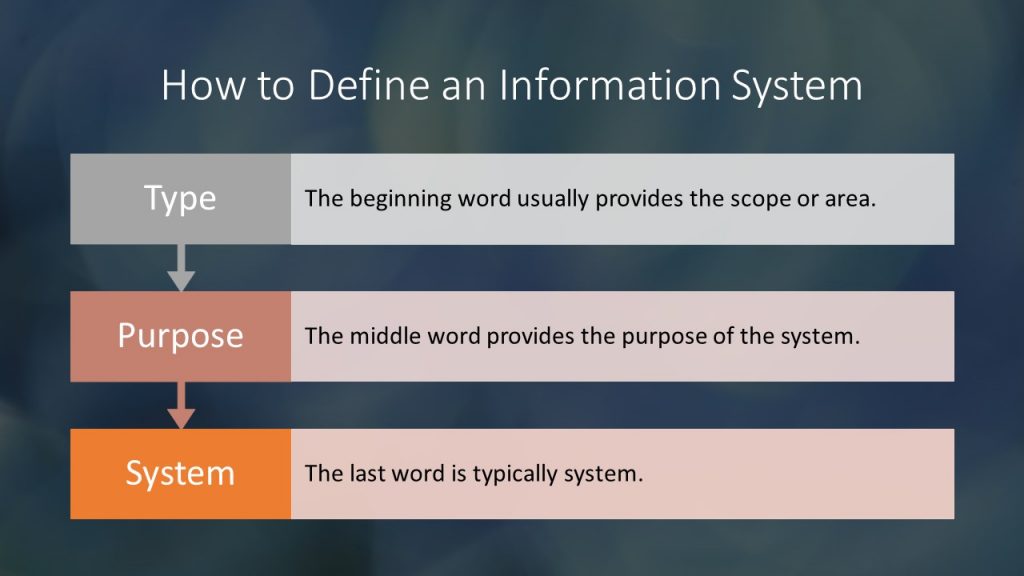
Using the TPS definition parameters and the definitions of each word, a ‘management system’ would be considered a collection of components working together to reach organizational goals while using organizational resources. ‘Management information’ would be considered presented data for the pursuit of organizational goals. Finally, ‘information system’ would be considered a collection of components that work together to present data in a context. A ‘context’, one should note, is presenting data in a perception that is meaningful to the end user or the person viewing the presented data. Altogether, a ‘management information system’ should be considered a collection of components working together to achieve organizational goals by presenting data in a meaningful context. Using the TPS parameters, this system would be limited in scope to management and its purpose is to produce information. It is also a system, which is discussed next. When comparing a geographic information system to a management information system, for example, both systems are systems that produce information, however, one is producing information for management and the other for geographic purposes. The type of system is critical to the purpose of the system as it drastically changes the functionality, appearance, and user interaction of the system.
The relationship between the data-to-value process and the input, process, output model
Referring to the definition above, the overall purpose of Information Systems is to produce information. To produce that information, data must be inputted into the system, analyzed (processed), and then outputted to the end user. So as an area of study, Information Systems is heavily involved in not only the creation of processing of data, but also providing value to users of the system. Value, in this context, is most defined as ‘the perception of worth an end user assigns to the presented information’.
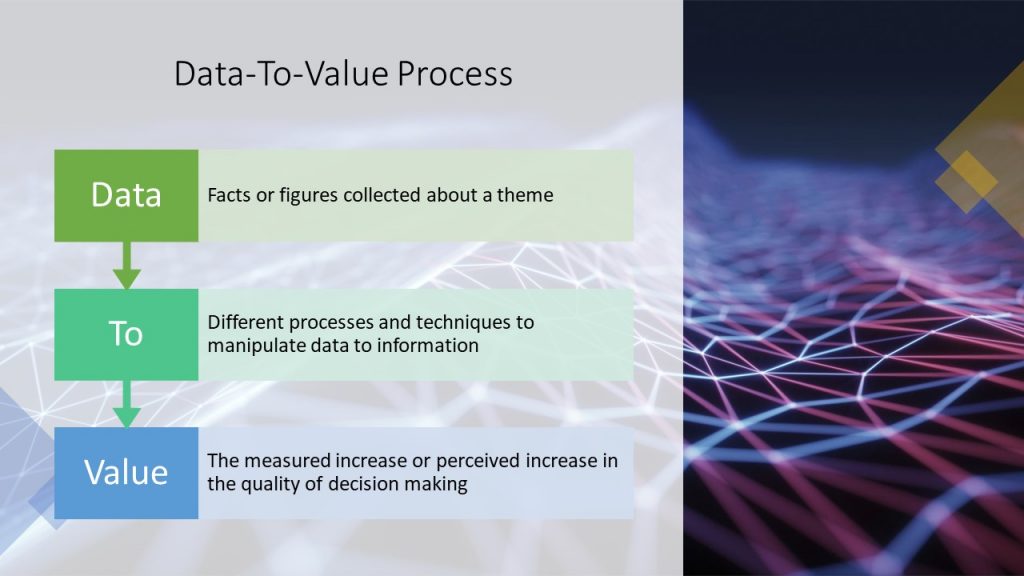
The conversion of ‘meaningless’ data into valued information follows a mature model of input, process, output (IPO). In one’s quest to understand information systems and their impact, the relationship between IPO and data-to-value helps to define the goals of a particular system and find areas for improvement within existing systems.
The input, process, output model is a common model that has been in existence for decades. Used mostly within software programs or processes, the IPO model is a great tool when also considering the data-to-value approach to understanding information systems. Data is generally considered an ‘input’ to an information system, and as the old saying goes: “garbage in, garbage out”. While mostly true, data can be manipulated within the processing stage to help improve the quality of the output. Within the IPO model, at any point ‘value’ can be added within the input phase, the processing phase, or the output phase. Increasing value in this case is increasing the quality of information and the quality of the perception by the user.
Input: In the information systems world data is almost always considered the input, so how can we improve the value? At the input stage improving the quality of the data will most likely provide the most value to the end user that only views the output stage. Specific strategies to improve data quality are dependent on the system design of the information systems in questions, however, there are some general tips.
- Automate data collection. Unfortunately, humans make mistakes, and these mistakes can be eliminated through automation.
- Database design will greatly impact your data quality. Revisit and revise the database and the data collection procedures often.
- Consider integrations. Since information systems can be composed of many different pieces, many different types of software may be used. Consider the compatibility of the different software programs.
Process: In this application of the IPO model process is referring to the value-adding activities that occur to the data to transform it into information. This may include analyzing the data using various statistical techniques and data aggregating, cleaning, transformation, and manipulation. Value-adding tips for this phase:
- Data validation – Checking and using techniques that ensure the integrity and accuracy of the data being processed.
- Using the appropriate statistical techniques to create the information needed.
- Applying analytical techniques such as trends and scenarios correctly to provide unbiased information.
Output: Output, or reporting, consists of activities that are designed to improve the visualization and usefulness of the information. In practice this is typically in the form of real-time dashboards and or static info graphics or more traditional reports. Some general tips for output are as follows:
- Create meaningful and minimal information visualizations that provide the information needed.
- Attempt to review and remove any bias that may be present in your visualizations.
- Create a standard design format for information tools to provide consistent and intuitive user experiences.
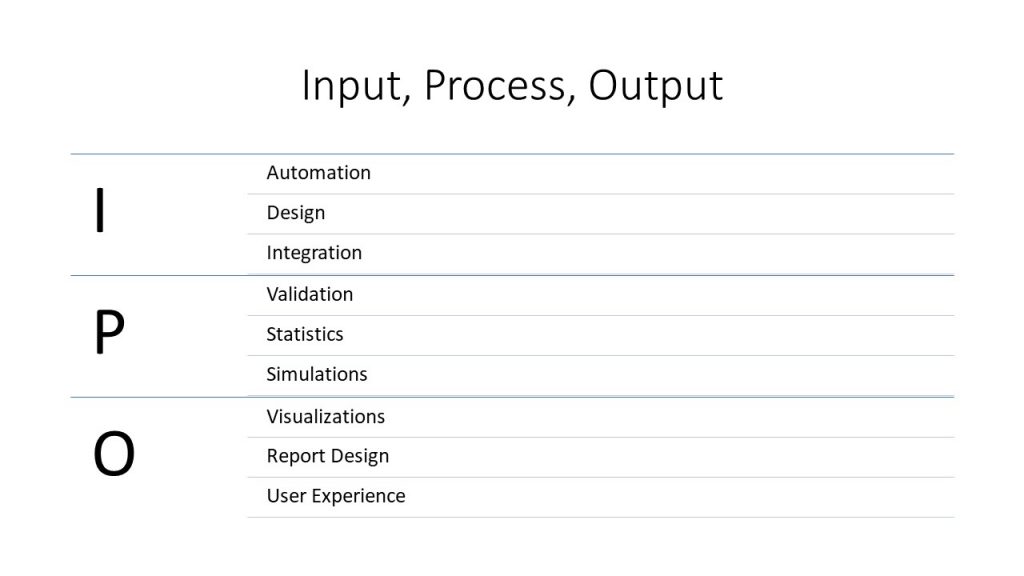
Decision-making and information
Perhaps one of the most common applications of information systems is decision-making. The information produced within an information system has the benefit of constantly being reproduced and updated – providing users with a common platform that can used individually or by many across the globe to be able to consistently use the same information to ideally make consistent decisions.
Information systems can also be used to automate decisions. Routine, or structured, decisions will typically follow a logical rule that allows the decision maker to use minimal or no effort to make the decision. For example, the decision to eat during the day should be a routine decision. However, it may become more complex to decide what you would like to eat! Information systems could be used to help you automate that decision, such as systems for dietary needs, wearables, etc.
While information systems and technology can help better automate routine decisions, the real power of information systems is in non-routine decision making. A non-routine decision is typically a complex decision that requires many facets of information to be considered simultaneously to help decrease the risk of making a bad decision. For example, purchasing a car would be considered a non-routine decision. There are many factors to consider, new versus used, type of car, etc. How does one decide which car to buy? Each factor provides its own wealth of information, of which can be of poor quality and biased. Even the fair price of a car can be a topic of debate. As people, in complex decisions such as this we tend to explore and utilize multiple resources simultaneously to help us ultimately make the decision. In information systems, one of the goals is to help unify and aggregate the information needed to help make the decision. Therefore, when you visit car buying sites you will see common items such as distance traveled (total miles), condition, year, and other common characteristics. Some sites will then provide you user ratings and reviews along with professional reviews from car experts.
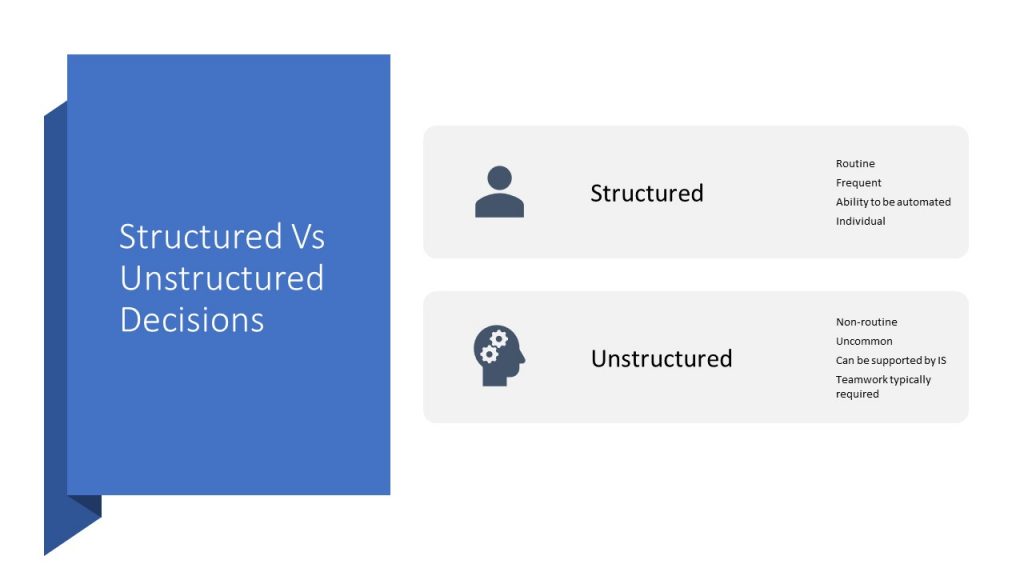
So how does a person know they are making the right decision, and can an information system tell them? The simple answer is no, however, information systems through artificial intelligence, data mining and machine learning are getting closer to helping users predict the likelihood of decision making as part of the process in aiding decision making.
IT vs. IS
Often Information Technology ‘IT’ and Information Systems ‘IS’ are used interchangeably, however, they are not equivalent. So, what’s the difference between technology and systems? The ‘technology’ is a subset of the systems world. This is related to the definition of the systems definition: a group of components working together. So, what are the components of an information system?
While various sources will list different numbers of components, most agree that systems are composed of hardware, software, data, procedures, and people. Dr. David Kroenke refers to this as the five-component framework. In the debate of information technology and information systems, hardware, software, and data can be grouped into ‘technology’ and data, procedures and people can be grouped into ‘people’. One may ask why data is in the middle and included on both sides. The simple answer is the technology creates the data; however, the purpose of the system is to produce information from the data. People, therefore, wouldn’t use the system without data and in many instances, people also create the data.
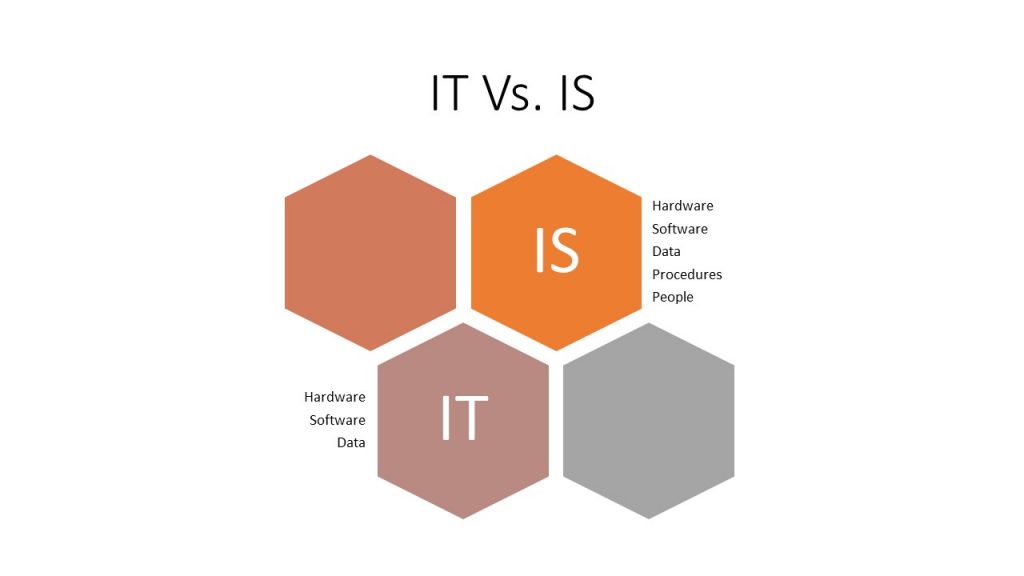
The rule of thumb to decide between whether a topic is an information technology or and information systems topic is to consider whether people are involved. If people are not highly involved, then it is likely an IT topic and if they are highly involved it is an IS topic. Organizations are beginning to reflect this difference by have a separate technology area and sometimes even department. This area would focus on improving the technology in the organization, while the information systems area would become more focused on how to migrate the new technologies into the organization. It is important to note that it is typically easy to change technologies, however, also getting the people in the organization can be very difficult due to the resistance to change.
Chapter 1 Assignment
This assignment is designed to help you understand the ‘skills’ gap that may or may not exist in your industry.
In this assignment you will explore the skills gap (or lack of) within your future career industry. Complete/answer the following questions in a separate word document and submit it to blackboard for grading.
Questions/Statements
- What industry do you plan to work in once you complete your academic career (this may be the same as your current employment)? Please describe your industry in detail and specifically your goals within the industry.
- Find an article that describes what is happening within your industry in regards to a skills gap. You may want to search ‘digital skills gap’. Is the gap widening? Shrinking? Changing? Why? Define the skills gap with numbers and definitions.
- Finally, conclude with how you plan to address the skills gap with your current academic career path. Specifically, outline skills that you may be missing and what courses, etc. will help you attain those skills.
Grading
A satisfactory submission will address the questions/statements above providing a description of the industry and the skills gap within the industry. An explanation comparing the gap to your current career path is also expected.
A beyond satisfactory submission may include detailed information about the skills gap within your industry and a detailed description of how the industry is addressing the skills gap. Further analysis will show the strengths or weaknesses your current career path may be providing and provide solutions for fulfilling those gaps or strengthening current plans.

